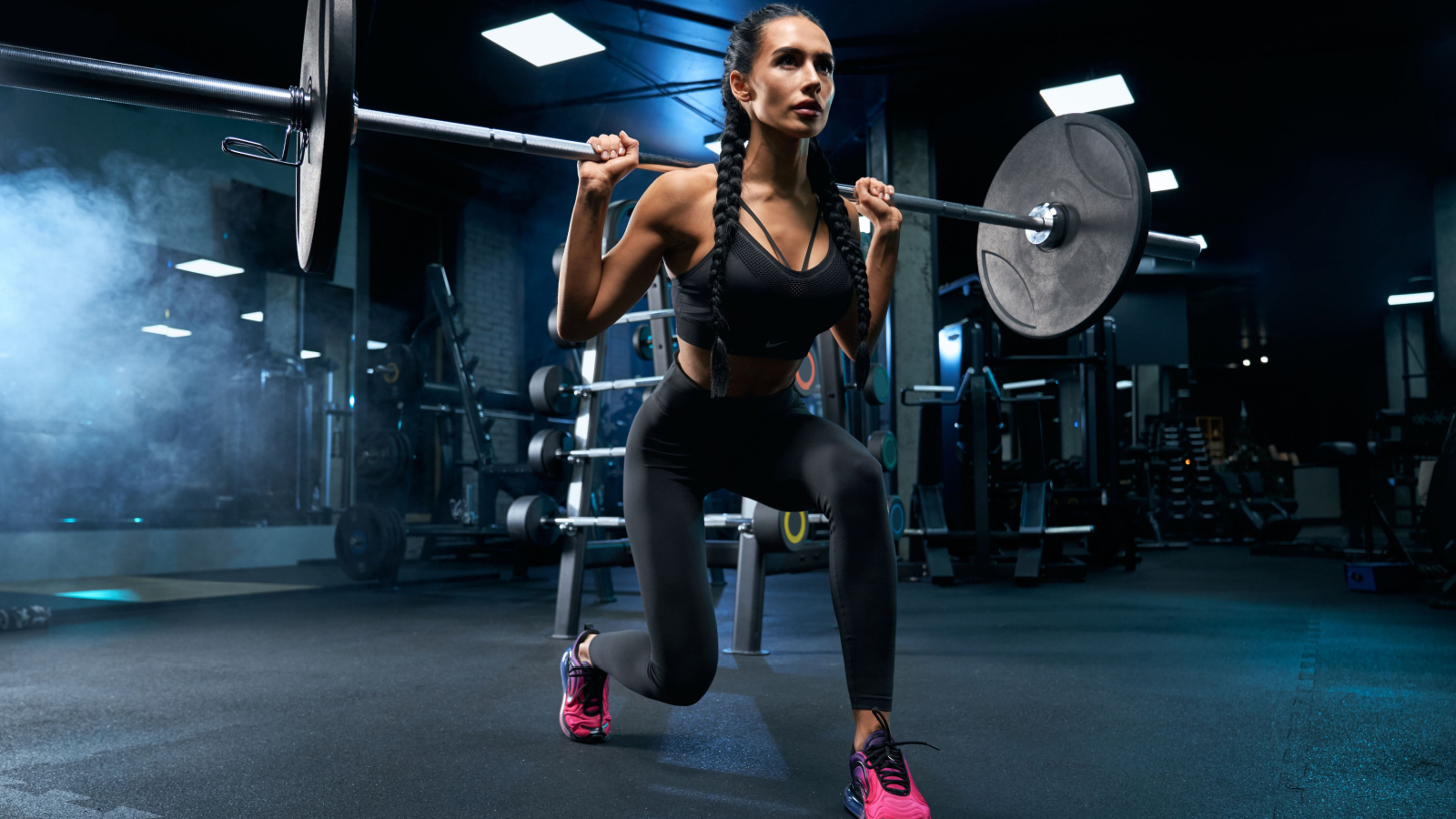Products You May Like
Whether you want to build an impressive set of wheels, boost your strength, or improve athletic performance, your training had better include some single-leg exercises. Indeed, they are invaluable for balancing your physique, addressing weaknesses, improving leg strength, and providing a nasty pump.
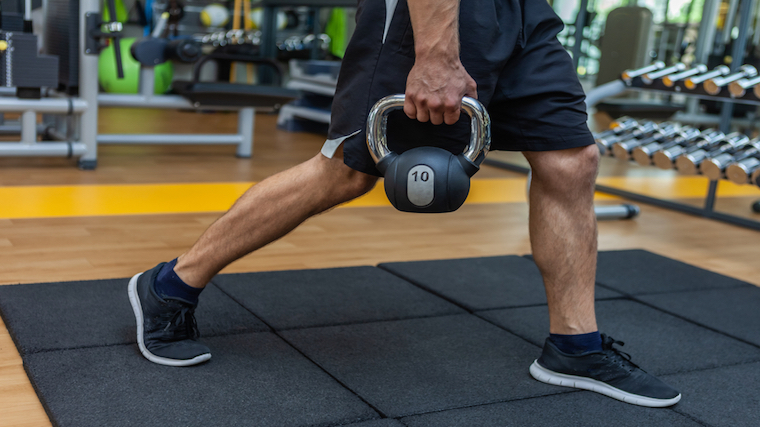
Among the best single-leg exercises are lunges, notorious for building pain tolerance along with well-developed legs. But should you perform the lunge dynamically, taking a step forward, or should it be done statically, also called a split squat? What are the differences and similarities between these exercises? Is there an even better way of doing lunges?
Let’s compare the split squat and the basic forward lunge, and figure out which could be the right choice for your plan.
Exercise Differences
At first glance, you might think there are no big differences between the forward lunge and the split squat, but you would be mistaken. One simple step forward changes several things.
Balance and Coordination
Unilateral exercises (working one limb at a time) have been shown to increase balance, agility, and coordination, as well as carrying over to injury prevention. (1) But you’re taking things a step forward with the lunge. Because your foot is not fixed in place and any added weights is moving as you step, typically dangling in your hands at arms length, the forward lunge is harder from a stability perspective because more total-body control is needed.
This makes the lunge a more effective variation if you want to improve these qualities, for instance, if you’re an athlete. (2) On the other hand, if you are prioritizing sheer strength and muscle-building, the static squat will be the superior choice. Relatively less motor control requirement means that you can use heavier weight, apply better control on the eccentric (lowering phase), and focus more on the mind-muscle connection which is critical for muscle gains. (3)
Muscle Recruitment
The instability of the lunge will shift the focus towards stabilizing muscles, which makes sense. If you’re doing lunges for firmer glutes, then you’ll be happy to hear that the three gluteal muscles will be recruited more significantly because they stabilize the hips and the upper leg. Indeed, they externally rotate and abduct the femur. On the other hand, the adductors stabilize the leg internally, and will also be more recruited.
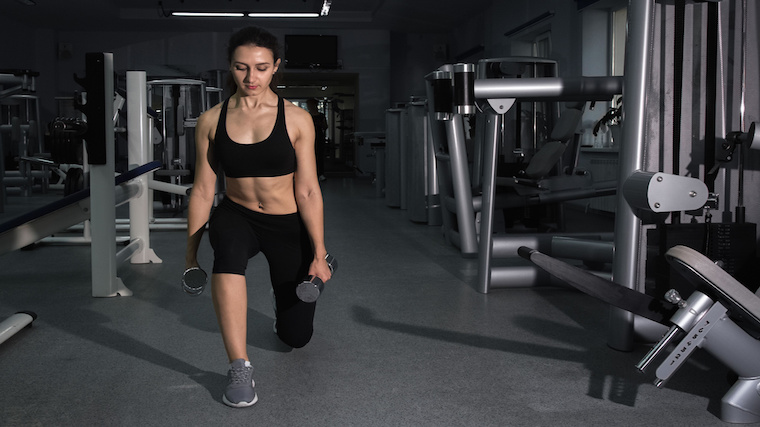
The abs, the lower back, and the other core muscles will have to work extra to compensate for the weight dangling around during the stepping process. Finally, the calves will have to be involved for when the lunge is done, they are used to propel yourself up back to the initial position. On the other hand, the static squat reducing the involvement of these muscles, it will be a better choice to scorch your quadriceps.
Exercise Similarities
The split squat, also called the static lunge, shares some clear similarities with the forward lunge.
Unilateral Leg Training
Both exercises involve knee extension and hip extension. As such, they target the same leg muscles — your quadriceps, glutes, adductors, and hamstrings. Your core will also be challenged to support the weight and balance your upper body.
As unilateral exercises, only one leg is working at a time. To be more precise, one leg is primarily working due to the staggered stance. Your rear leg is used for support and will still contribute to the movement in a small degree, but the bulk of the weight has to be supported and driven by the front leg.
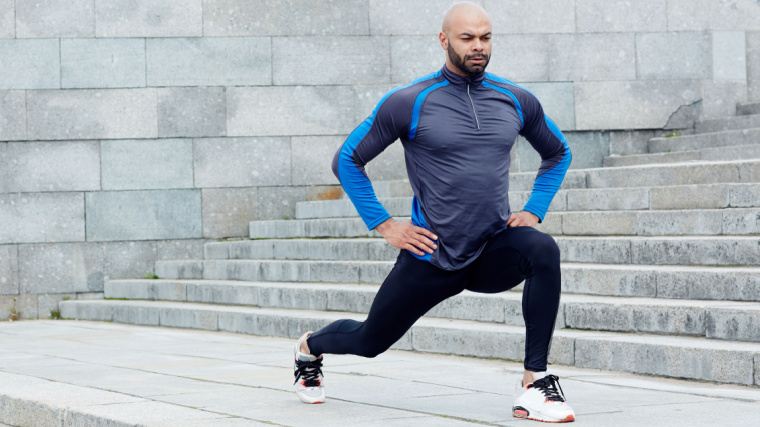
Both of these exercises will contribute to improved balance, stability, and coordination. Emphasizing each leg on its own will also be helpful to balance your any potential developmental weaknesses between sides. (4)
How to Do the Split Squat
With the split squat being generally more stable than the forward lunge, you can capitalize on the opportunity to safely use barbells to add resistance. Position yourself in front of a rack, place the barbell on the “shelf” of your upper back and unrack it. Take a few small steps back to make room to perform the exercise. Take a shallow step forward with one leg, and one small step backward with the other leg, ending up in a half-lunge position with a hip-width stance.
Brace your core and bend your legs until your rear knee grazes the floor. Press the weight up by driving through your front foot. Make sure most of your weight is on your front leg. Repeat for the desired amount of repetitions before racking the bar and switching legs.
Form tip: Keep your front foot flat on the ground during the exercise. Focus on pushing through your heel to ensure maximal glute engagement and leg stability.
Benefits of the Split Squat
- The split squat is the unilateral “squatting motion” exercise that will allow you to use the most weight, making it a great choice for building strength.
- This stable exercise allows you to focus on time under tension, mind-muscle connection, and going to failure relatively safely for an excellent hypertrophy stimulus.
Split Squat Variations
There are several ways to perform a split squat in order to better suit your specific goals. Add them, if needed, once you’ve mastered the basic split squat.
Bulgarian Split Squat
This infamous exercise, often known for creating post-workout soreness, is also one of the best lower-body builders there is. To do the Bulgarian split squat, you elevate your rear leg on a box or a bench, and then perform a traditional split squat. The elevated foot allows you to potentially reach a much deeper stretch and a longer range of motion. This can help focus even more on your glutes and build hip mobility in a new way for deeper squats and better lower body function.
This exercise is better done later in a workout for moderate to high repetitions. If you want to challenge your glutes and core even more, hold a single dumbbell or kettlebell in the hand opposed to the front leg.
Smith Machine Split Squat
The split squat has the advantage of being more stable, but why not take things a step further and use the Smith machine to provide maximal stability? This way, you can safely scale up the intensity, reach closer to muscular failure, and focus on the mind-muscle connection ensuring maximal hypertrophy.
Position yourself in the middle of the Smith machine, assume a half-lunge position, and unrack the bar before performing the exercise. Complete all reps with one leg before switching sides.
Front Rack Split Squat
The front rack split squat requires more upper body mobility to assume the front rack position with a barbell, similar to performing a front squat. Any potential awkwardness in learning the bar position is compensated by increased efficiency and greater total-body muscle.
Holding the bar this way will target more your quadriceps as well as your upper back and core. If the front rack position is too hard for you, either try the “California grip” variation with your arms crossed over the bar or switch the barbell for a pair of kettlebells or dumbbells.
How to Do the Lunge
Stand tall with a pair of dumbbells in your hands and your arms straight down by your sides. Take a breath and brace your core before stepping forward with one foot. Keep your shoulders back and your torso upright. Bend your legs with control until they both form a nearly 90-degree angle and your rear knee barely grazes the floor. Keep your front foot flat with most of your weight on your front leg.
Drive through your front heel to raise yourself back up, and push through your toe to get back in the initial position. Repeat with the other leg. Finding your forward footing is an added challenge to your stability and balance, so make sure you start with relatively lighter weights.
Form tip: Beware not to use too narrow a step forward, which will compromise your balance and stability. Stepping too far, however, will not allow a significant range of motion and will decrease muscle recruitment.
Benefits of the Lunge
- Improved neuromuscular control, stabilization, and balance, because of the challenge created by the dynamic motion.
- Promotes core and a complete lower-body development — quadriceps, hamstrings, glutes, and calves.
Lunge Variations
When the forward lunge is no longer a secret to you, try these variations to spice up your training or to focus more on certain benefits of the lift.
Walking Lunge
The lunge is dynamic in nature, so why not make it even more dynamic? The walking lunge will challenge your motor control and body awareness even more, as well as provide a robust stimulus for muscle growth because of the constant time under tension.
You can also use these to challenge your heart rate, and add a strength training element to your cardio routine.
Reverse Lunge
It might not seem like there’s a difference between stepping backward or stepping forward, but there actually is. The reverse lunge is a relatively safer and more stable exercise that can decrease knee stress.
It’s easier to control the eccentric and maintain your balance, making it an effective choice for size and strength.
Pendulum Lunge
This advanced variation will challenge your neuromuscular control like no other. It essentially combines a forward lunge and a reverse lunge into a single repetition. To perform it, step forward into a lunge, descend, and return to the initial position. Without letting your foot rest on the ground, immediately step back and transition into a reverse lunge.
This exercise challenges your whole body stability, making it a highly effective choice to reinforce your stabilizer muscles or jack up your heart rate because so many muscles are involved during each repetition.
How to Program the Right Movement
The split squat and lunge are both multi-joint free-weight exercises. As such, you can include these in any training program for a variety of goals, be it strength, size, or cardiovascular capacities.
Building Strength
Technically, experienced lifters could perform the split squat for sets of three, or even heavy single repetitions as long as form is maintained. However, the vast majority of lifters should stick to three to five sets of five to eight repetitions. This will ensure the best blend of size and strength to your wheels with a reduced risk of injuries, which can be increased during exercises with high stability requirements.
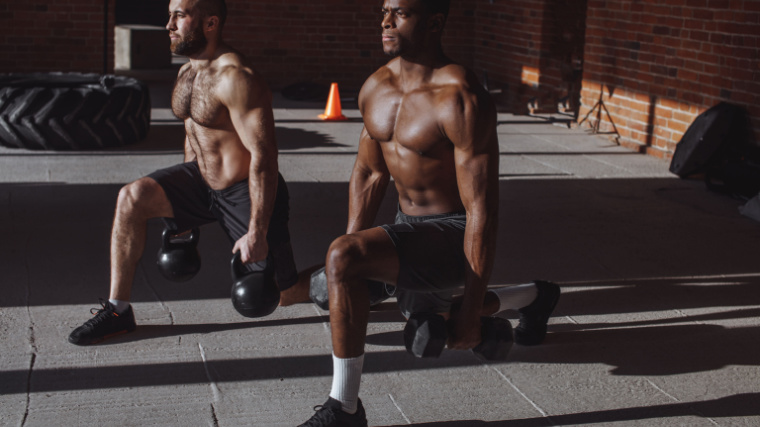
The forward lunge is not well-suited to very heavy weights because knee strain and impact can be increased during the stepping portion of the movement.
Building Muscle
If you’re more concerned with maximal size and a burning sensation in your legs, two to four sets of 10 to 15 repetitions of either the split squat or the lunge will scorch your lower body and core. Both exercises will provide an excellent hypertrophy stimulus, particularly when performed after your main heavy exercises.
Bodyweight-Only Cardio Training
Adding a strength training element to your cardio routine is a great way to develop multiple qualities at the same time — size, cardio, athleticism, strength. In fact, science has shown that bodyweight circuits can be as effective as any other form of cardio (treadmill, biking, etc.) to build endurance and shed body fat. (5)
Including these in your circuits is a great way to build your heart and your lower body at the same time. If you want to test your mettle, you can try performing walking lunges for distance, or for very high reps, one or two days per week. Aim to increase the distance or total repetitions each week.
- Week One: 50 lunges total reps per leg
- Week Two: 75 lunges total reps per leg
- Week Three: 100 lunges total reps per leg
- Week Four: 125 lunges total reps per leg
- Week Five: 150 lunges total reps per leg
- Week Six: 200 lunges total reps per leg
- Week Seven: 225 lunges total reps per leg
- Week Eight: 250 lunges total reps per leg
Battle for Better Legs
There are many possible ways to lunge, but as long as your working includes either the split squat or lunge, you’re on the right path to bigger, stronger legs. Now that the differences and advantages of each variation are laid out, include the movement best suited to your specific goals and needs, and take a step toward stronger, more muscular, more powerful legs.
References
- Speirs, Derrick E.1,2; Bennett, Mark A.3; Finn, Charlotte V.4; Turner, Anthony P.2. Unilateral vs. Bilateral Squat Training for Strength, Sprints, and Agility in Academy Rugby Players. Journal of Strength and Conditioning Research 30(2):p 386-392, February 2016. | DOI: 10.1519/JSC.0000000000001096
- Ramirez-Campillo, Rodrigo & Burgos, Carlos & Henríquez-Olguín, Carlos & Andrade, David & Martínez, Cristian & Álvarez, Cristian & Castro-Sepulveda, Mauricio & Marques, Mário & Izquierdo, Mikel. (2015). Effect of Unilateral, Bilateral, and Combined Plyometric Training on Explosive and Endurance Performance of Young Soccer Players. The Journal of Strength and Conditioning Research. 29. 1317–1328. 10.1519/JSC.0000000000000762.
- Calatayud J, Vinstrup J, Jakobsen MD, Sundstrup E, Brandt M, Jay K, Colado JC, Andersen LL. Importance of mind-muscle connection during progressive resistance training. Eur J Appl Physiol. 2016 Mar;116(3):527-33. doi: 10.1007/s00421-015-3305-7. Epub 2015 Dec 23. PMID: 26700744.
- Núñez FJ, Santalla A, Carrasquila I, Asian JA, Reina JI, Suarez-Arrones LJ. The effects of unilateral and bilateral eccentric overload training on hypertrophy, muscle power and COD performance, and its determinants, in team sport players. PLoS One. 2018 Mar 28;13(3):e0193841. doi: 10.1371/journal.pone.0193841. PMID: 29590139; PMCID: PMC5874004.
- Kim JW, Ko YC, Seo TB, Kim YP. Effect of circuit training on body composition, physical fitness, and metabolic syndrome risk factors in obese female college students. J Exerc Rehabil. 2018 Jun 30;14(3):460-465. doi: 10.12965/jer.1836194.097. PMID: 30018934; PMCID: PMC6028228.
Featured Image: Serhii Bobyk / Shutterstock
